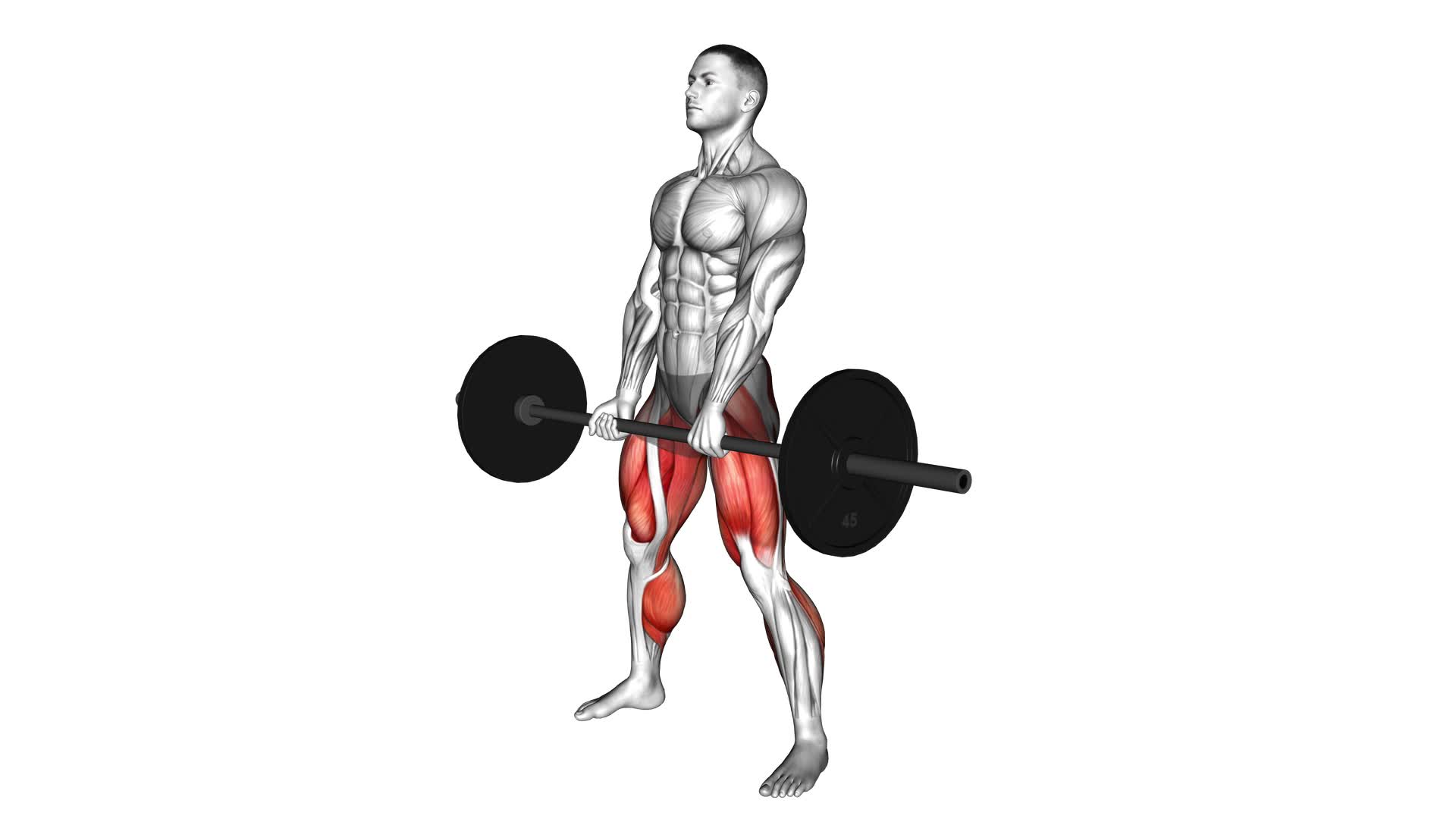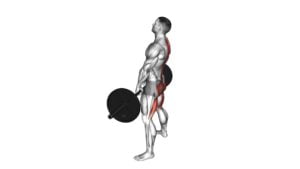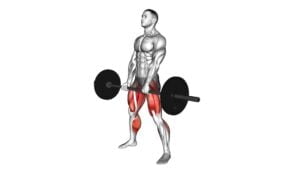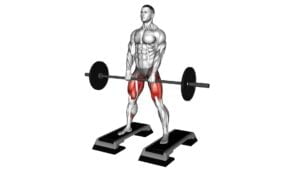Barbell Sumo Deadlift – Video Exercise Guide & Tips

Looking to strengthen your lower body and build explosive power? The barbell sumo deadlift is the perfect exercise for you. In this video exercise guide, we'll walk you through the proper form and technique, provide tips for maximizing your workout, and highlight common mistakes to avoid.
Watch This Exercise Video
Whether you're a beginner or an experienced lifter, this exercise will help you build strength, improve your mobility, and take your fitness to the next level.
Get ready to lift and feel the burn!
Key Takeaways
- Barbell Sumo Deadlift builds explosive power and strengthens the lower body.
- It targets major muscle groups including glutes, quadriceps, hamstrings, and lower back.
- The wider stance and toes pointed outward increase activation of glutes and inner thigh muscles.
- It places less stress on the lower back compared to the conventional deadlift.
Benefits of the Barbell Sumo Deadlift
You can experience significant strength gains by incorporating the Barbell Sumo Deadlift into your workout routine. This exercise specifically targets several major muscle groups, making it an effective addition to any strength training program. The primary muscles targeted in the Barbell Sumo Deadlift are the glutes, quadriceps, hamstrings, and lower back. By performing this exercise, you can develop stronger and more defined muscles in these areas.
When comparing the Barbell Sumo Deadlift to the conventional deadlift, there are a few key differences to consider. Firstly, the stance used in the Barbell Sumo Deadlift is wider and the toes are pointed outward. This wider stance allows for increased activation of the glutes and inner thigh muscles. In contrast, the conventional deadlift utilizes a narrower stance with the toes pointed forward, placing more emphasis on the hamstrings and lower back.
Additionally, the Barbell Sumo Deadlift places less stress on the lower back compared to the conventional deadlift. This is due to the more upright torso position and the wider grip used in the Barbell Sumo Deadlift, which helps to distribute the load more evenly throughout the body.
Proper Form and Technique
To perform the Barbell Sumo Deadlift with proper form and technique, begin by positioning your feet in a wide stance and pointing your toes outward. This wide stance allows for a greater range of motion and engages the muscles in your hips and inner thighs.
Place the barbell on the ground in front of you, making sure it's centered between your feet. Bend at the hips and knees, reaching down to grip the bar with your hands. There are two common grip options for the Barbell Sumo Deadlift: the double overhand grip and the mixed grip. The double overhand grip involves gripping the bar with both palms facing towards you. The mixed grip involves gripping the bar with one palm facing towards you and the other palm facing away. Choose the grip that feels most comfortable and secure for you.
As you begin to lift the bar, keep your back straight and your chest up. Drive through your heels, pushing your hips forward to stand up straight. Avoid rounding your back or lifting with your arms.
Common mistakes to watch out for include lifting with your back instead of your legs, allowing your knees to collapse inward, and using too heavy of a weight that compromises your form.
Remember to start with lighter weights and gradually increase as you become more comfortable and confident in your technique.
Equipment Needed for the Exercise
To perform the Barbell Sumo Deadlift with proper form and technique, it's essential to have the necessary equipment. Here are the items you'll need to complete this exercise effectively:
- Barbell: The barbell is the main piece of equipment for the Barbell Sumo Deadlift. It provides the resistance needed to work your muscles and build strength.
- Weight plates: You'll need weight plates to add resistance to the barbell. Start with a weight that challenges you but allows you to maintain proper form.
- Power rack or lifting platform: Having a stable surface to perform the Barbell Sumo Deadlift is crucial. A power rack or lifting platform provides a secure area for you to lift the barbell.
- Lifting straps or chalk: Depending on your grip strength, you may choose to use lifting straps or chalk to improve your grip on the barbell.
Using the right equipment for the Barbell Sumo Deadlift has several benefits. It allows you to lift heavier weights, engage more muscle groups, and increase overall strength. Additionally, using the proper equipment reduces the risk of injury and ensures your safety during the exercise.
If you don't have access to the necessary equipment, there are alternative exercises you can try. These include the dumbbell sumo deadlift, kettlebell sumo deadlift, or resistance band sumo deadlift. These exercises target similar muscle groups and can be effective substitutes.
Now that you know what equipment you need for the Barbell Sumo Deadlift, let's move on to the next section and discuss the common mistakes to avoid.
Common Mistakes to Avoid
One common mistake to avoid when performing the Barbell Sumo Deadlift is neglecting proper hip alignment. It's crucial to maintain proper form throughout the exercise to prevent injury and maximize the effectiveness of the movement.
Many individuals make the mistake of allowing their hips to tilt forward or backward, which can put unnecessary strain on the lower back and compromise the stability of the lift. To avoid this, focus on keeping your hips in line with your knees and shoulders throughout the entire movement. Imagine a straight line running from your head down to your tailbone, and make sure your hips stay in alignment with this line.
Another common mistake is using too much weight too soon. It's important to start with a weight that allows you to maintain proper form and gradually increase the weight as your strength and technique improve.
Finally, avoid rushing through the exercise. Take your time to set up properly, engage your core, and lift the weight with control. Rushing can lead to sloppy technique and increase the risk of injury.
Variations and Progressions
When it comes to variations and progressions in the barbell sumo deadlift, there are a few key points to keep in mind.
First, consider experimenting with different grip options, such as an overhand grip or mixed grip, to target different muscle groups and add variety to your training.
Additionally, it's important to gradually increase the weight you lift to challenge your muscles and continue making progress over time.
Different Grip Options
Choose from various grip options to add variety and challenge to your barbell sumo deadlifts. Different grip techniques not only provide different hand positions but also help to improve grip strength, which is essential for lifting heavier weights.
Here are four grip variations to try:
- Overhand Grip: This is the most common grip technique, where both palms face the body. It emphasizes grip strength and targets the muscles of the forearm.
- Mixed Grip: In this grip, one palm faces towards the body (pronated) and the other faces away (supinated). It helps to improve grip strength and prevents the barbell from rolling out of your hands.
- Hook Grip: This grip involves wrapping your thumb around the bar and then wrapping your fingers over the thumb. It provides a secure grip and is commonly used by weightlifters.
- Straps: If you have difficulty maintaining a strong grip, you can use lifting straps to support your hands. However, it's important to note that relying too much on straps may limit your grip strength development.
Experiment with these grip variations to challenge your muscles and enhance your grip strength during barbell sumo deadlifts.
Increasing Weight Gradually
To continue progressing in your barbell sumo deadlifts, gradually increase the weight you lift while maintaining proper form and technique. Increasing the weight you lift is essential for building strength and challenging your muscles to grow.
However, it's crucial to do so gradually to prevent injuries. Start by adding small increments to the weight you lift, such as 5-10 pounds, and focus on maintaining proper form throughout each repetition.
As you become more comfortable with the new weight, you can continue to increase it gradually over time. Remember to listen to your body and avoid pushing yourself too hard, as this can increase the risk of injury.
Tips for Maximizing Your Workout
To maximize your workout, it's crucial to focus on proper form techniques.
Maintaining a neutral spine, engaging your core, and keeping your knees in line with your toes are key elements to ensure you're performing the barbell sumo deadlift correctly.
Additionally, incorporating effective exercise variations, such as using different grips or adding resistance bands, can help target specific muscle groups and enhance the overall intensity of your workout.
Proper Form Techniques
Mastering proper form techniques is crucial for maximizing your workout during the Barbell Sumo Deadlift. To ensure you get the most out of this exercise, here are some key tips to follow:
- Breathing techniques: Proper breathing can help stabilize your core and enhance your lifting power. Inhale deeply before you start the lift and exhale forcefully as you lift the barbell.
- Hip mobility: Flexibility in your hips is essential for maintaining proper form. Stretching and mobility exercises can help improve hip mobility, allowing you to achieve a deeper squat position and engage your glutes more effectively.
- Maintain a neutral spine: Keep your back flat throughout the lift, avoiding any rounding or excessive arching. This protects your spine and ensures proper muscle activation.
- Engage your glutes: Focus on squeezing your glutes as you lift the barbell, driving the movement from your hips rather than relying solely on your lower back.
Effective Exercise Variations
Maximize your workout and achieve optimal results with these effective exercise variations for the Barbell Sumo Deadlift.
By making exercise modifications, you can target different muscle groups and challenge your body in new ways.
One variation is the Romanian Sumo Deadlift, which focuses on the hamstrings and glutes. To perform this, start with a wider stance and the barbell in front of you. Hinge at the hips and lower the barbell while keeping your back straight.
Another variation is the Single-Leg Sumo Deadlift, which targets the stabilizing muscles of the hips and improves balance. Stand on one leg, reach down and grab the barbell with one hand, and lift it while keeping your leg extended.
These exercise variations will add variety to your workout routine and help you achieve a well-rounded lower body workout.
Frequently Asked Questions
How Many Sets and Reps Should I Do When Performing the Barbell Sumo Deadlift?
When performing the barbell sumo deadlift, it's important to consider how many sets and reps to do.
The barbell sumo deadlift is a great exercise that has numerous benefits, such as targeting different muscles compared to other variations of deadlifts.
To determine the number of sets and reps, it's best to start with a weight that challenges you but allows you to maintain proper form.
Gradually increase the weight and aim for 3-4 sets of 8-12 reps to build strength and endurance.
Can I Substitute the Barbell Sumo Deadlift With Other Exercises for Similar Benefits?
You're wondering if you can replace the barbell sumo deadlift with other exercises for similar benefits.
It's important to note that while there are exercises that target similar muscle groups, the barbell sumo deadlift is unique in its ability to engage multiple muscles simultaneously.
It's particularly effective for developing strength in the hips, glutes, and inner thighs.
However, if you're looking for substitute exercises, you could consider kettlebell sumo deadlifts or dumbbell sumo squats, which also work the same muscle groups.
Is It Necessary to Wear Weightlifting Shoes When Performing the Barbell Sumo Deadlift?
When performing the barbell sumo deadlift, you might be wondering if it's necessary to wear weightlifting shoes.
Well, weightlifting shoes can provide several benefits for this exercise. They have a raised heel that improves ankle mobility and allows you to maintain a more upright posture. This can help you engage your glutes and hamstrings more effectively.
However, if you don't have weightlifting shoes, don't worry! You can still perform the barbell sumo deadlift with proper form by wearing flat-soled shoes or going barefoot.
How Often Should I Incorporate the Barbell Sumo Deadlift Into My Workout Routine?
To effectively incorporate the barbell sumo deadlift into your workout routine, it's recommended to do it at least once or twice a week. This will allow your body to adapt to the movement and build strength in your lower body and core.
It's important to remember that the barbell sumo deadlift is just one variation of the deadlift exercise. By incorporating other deadlift variations, such as the conventional deadlift, you can target different muscle groups and achieve a more well-rounded workout.
Are There Any Specific Warm-Up Exercises That I Should Do Before Attempting the Barbell Sumo Deadlift?
Before attempting the barbell sumo deadlift, it's important to warm up properly. There are specific warm-up exercises you should do to prepare your body for this movement.
These exercises can help increase blood flow, improve flexibility, and activate the muscles you'll be using during the deadlift. By warming up properly, you can reduce the risk of injury and enhance your performance.
Conclusion
In conclusion, the barbell sumo deadlift is a highly effective exercise that targets multiple muscle groups and can help improve overall strength and power.
By using proper form and technique, utilizing the right equipment, and avoiding common mistakes, you can maximize the benefits of this exercise.
Additionally, by incorporating variations and progressions, you can continue to challenge yourself and make progress in your fitness journey.
Remember to follow the tips provided to ensure a safe and effective workout.

Author
Years ago, the spark of my life’s passion ignited in my mind the moment I stepped into the local gym for the first time. The inaugural bead of perspiration, the initial endeavor, the very first surge of endorphins, and a sense of pride that washed over me post-workout marked the beginning of my deep-seated interest in strength sports, fitness, and sports nutrition. This very curiosity blossomed rapidly into a profound fascination, propelling me to earn a Master’s degree in Physical Education from the Academy of Physical Education in Krakow, followed by a Sports Manager diploma from the Jagiellonian University. My journey of growth led me to gain more specialized qualifications, such as being a certified personal trainer with a focus on sports dietetics, a lifeguard, and an instructor for wellness and corrective gymnastics. Theoretical knowledge paired seamlessly with practical experience, reinforcing my belief that the transformation of individuals under my guidance was also a reflection of my personal growth. This belief holds true even today. Each day, I strive to push the boundaries and explore new realms. These realms gently elevate me to greater heights. The unique combination of passion for my field and the continuous quest for growth fuels my drive to break new ground.







